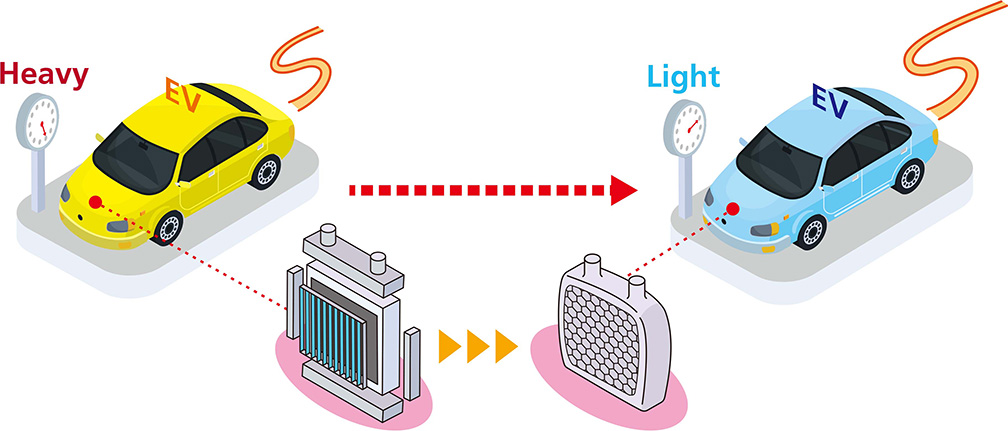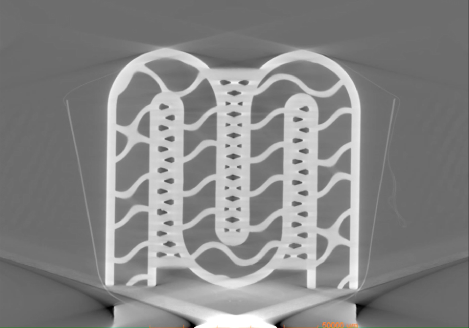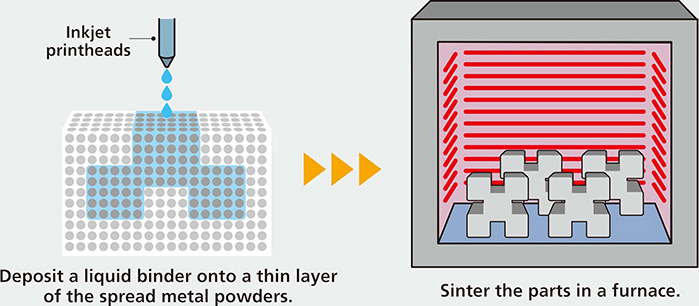- Home
- Ricoh's Technology
- Metal 3D Printing Based on Binder Jetting Method
Metal 3D Printing Based on Binder Jetting Method
Metal 3D printers are capable of making complex, intricate metal parts that conventional processing methods cannot produce. Ricoh has been developing 3D printing technology that enables mass production of aluminum parts which are widely used as they conduct heat well and are lightweight.
Background
In the transportation sector, there are high hopes for new lightweight materials and improvements in heat exchange efficiency. This will help achieve the widespread use of electric vehicles and aircraft, which will contribute to the mitigation of atmospheric pollution and a reduction in CO2. To make renewable energy more widely used, semiconductors are required to operate more efficiently to enhance energy efficiency and output power. Leading companies have been developing novel metal parts that enable such technological advances, but conventional processing methods have limited capabilities to model shapes. Furthermore, conventional metal 3D printers have issues with productivity and cost, which are major obstacles to the mass production of novel metal parts.

Solutions
Ricoh's metal 3D printing technology enables the production of metal parts with more complex shapes, such as intricate narrow tubes. Production of such parts wouldn't be possible with conventional metal processing methods such as casting and cutting.

Technical highlights
Various methods are currently in use for 3D printers. Ricoh uses the highly reliable binder jetting method, which applies Ricoh’s inkjet printing technology.
<Binder jetting method>
Metal powder is spread out over the modeling area, and an adhesive binder is deposited onto it. The part is then strengthened by sintering it in a furnace.

Ricoh has been developing high-definition industrial inkjet printheads and applying this technology to the development of a metal 3D printing technology that can reliably produce metal parts despite its high speed.
(Major features)
- Specially formulated alloy powder and binder, and sintering method that enables the production of aluminum parts with the binder jetting method
Aluminum parts are useful as heat exchangers. To produce them with the binder jetting method, aluminum powder needs to be sintered. However, aluminum powder has a strong surface oxide on its surface, preventing the sintering of aluminum powder. As a solution to this issue, Ricoh is developing a specially formulated Al-alloy powder, binder, and sintering method tailored to these conditions.

- Excess powder removal technology that enables intricately shaped parts
Before the parts can be sintered, any excess powder must be removed from the areas where the binder has not been applied. Brushes and air blowers, however, can fail to remove all powder when the part's shape is very intricate. Ricoh has been developing a technology that easily removes the excess powder through immersion in a solvent. The technology allows parts with very intricate structures, such as narrow internal channels, to be modeled.

Ricoh's vision
Ricoh will provide manufacturers with AM solutions—devices, materials, and know-how—that contribute to manufacturing innovation and address social issues.
Related links
Sorted by : field “Inkjet” “Energy Conservation” “Precision Machining”